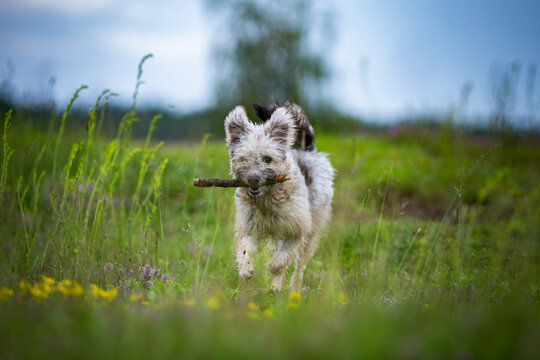The Pumi is a small, energetic, and intelligent dog breed that has been steadily gaining popularity among dog enthusiasts. Originally hailing from Hungary, Pumis were bred as herding dogs, which is why they possess an innate ability to quickly learn and execute tasks. Their high level of intelligence, combined with their friendly and affectionate nature, make them a joy to train and live with. In this blog post, we will explore some of the best training techniques for your clever Pumi canine, ensuring that you become Pumi-proficient in no time!
Understanding Your Pumi’s Unique Traits
Before diving into specific training techniques, it’s essential to understand your Pumi’s unique traits and instincts. As herding dogs, Pumis have the instinct to control the movement of other animals, such as livestock. They are also agile, alert, and highly responsive to commands. This innate intelligence and ability to learn quickly make them suitable for a wide range of dog sports and activities, such as agility, obedience, and even doggy dancing! Understanding your Pumi’s inherent traits will help you tailor your training methods to their strengths and preferences, ensuring successful and enjoyable sessions.
Positive Reinforcement Training
One of the most effective and enjoyable training methods for Pumis is positive reinforcement training. This technique focuses on rewarding your dog for desired behaviors, thereby encouraging them to repeat these actions. You can use treats, praise, toys, or any other reward that your Pumi finds motivating. Some key aspects of positive reinforcement training include:
1. Timing: Reward your Pumi immediately after they perform the desired behavior to create a strong association between the action and the reward.
2. Consistency: Be consistent with your commands and rewards, ensuring that your Pumi understands what is expected of them.
3. Gradual Progression: Start with simple commands and gradually increase the difficulty of the tasks as your Pumi becomes more proficient.
4. Patience: Training takes time, and it’s essential to be patient and persistent with your Pumi. Remember, this is a bonding experience for both of you.
Clicker Training
Clicker training is a powerful training method that uses a small device that produces a distinct clicking sound to mark desired behaviors. When used in conjunction with positive reinforcement, clicker training can be an incredibly effective technique for teaching your Pumi new commands and tricks. To get started with clicker training:
1. Charge the clicker: This means creating an association between the sound of the clicker and a reward. To do this, click the device and immediately give your Pumi a treat. Repeat this process multiple times until your dog understands that the click means a reward is coming.
2. Mark desired behaviors: Once the clicker is charged, use it to mark desired behaviors by clicking the moment your Pumi performs the action you want to reinforce.
3. Add verbal cues and hand signals: As your Pumi becomes more familiar with the clicker, you can begin to pair the clicking sound with verbal commands and hand signals.
4. Fade the clicker: Gradually decrease the use of the clicker as your Pumi becomes more proficient at performing the desired behaviors. Eventually, you can phase out the clicker entirely and rely solely on verbal cues and hand signals.
Socialization and Building Confidence
Socialization is a critical aspect of training your Pumi, as it helps them develop into well-rounded, confident, and well-behaved dogs. Pumis are naturally curious and friendly, so exposing them to various people, animals, and environments will help them build confidence and adapt to new situations.
Building a Strong Foundation with Basic Commands
To become Pumi-proficient, start by teaching your dog the basic commands that will form the foundation of their training. These commands include:
1. Sit: Hold a treat near your Pumi’s nose and slowly raise it upwards, encouraging them to sit. As soon as they sit, say “sit,” click, and reward them with the treat.
2. Stay: With your Pumi in a sitting position, hold your palm out in front of your face and say “Stay.” Take a few steps back and, if they remain seated, return to them, click, and reward. Gradually increase the distance and duration of the “stay” command.
3. Come: Start with your Pumi on a leash and in a sitting position. Walk a short distance away and, with an enthusiastic tone, say “Come” while gently pulling the leash towards you. As they approach you, click and reward. Gradually increase the distance and practice the command off-leash once they become reliable.
4. Lie down: With your Pumi in a sitting position, hold a treat near their nose and slowly lower it to the ground, encouraging them to lie down. As they lie down, say “down,” click, and reward.
5. Leave it: Place a treat on the floor and cover it with your hand. When your Pumi attempts to take the treat, say “leave it” and do not allow them to take it. Once they stop trying to get the treat, click, and reward them with a different treat from your other hand.
Advanced Training Techniques and Activities
Once your Pumi has mastered the basic commands, you can begin to explore more advanced training techniques and activities to keep them mentally and physically stimulated. Some options include:
- Agility: Pumis excel at agility due to their natural athleticism and quick learning ability. Enroll in an agility class or create a homemade agility course in your backyard to challenge your Pumi and strengthen the bond between you.
- Obedience trials: Pumis are known for their high level of obedience, making them excellent candidates for obedience trials. Training for and participating in these events can be a fun and rewarding experience for both you and your Pumi.
- Herding exercises: Tap into your Pumi’s natural herding instincts by engaging in herding exercises and activities. Many training centers offer herding classes or workshops, which can be a fantastic way to channel your Pumi’s energy and intelligence.
- Trick training: Teaching your Pumi new tricks is a great way to keep their mind engaged and strengthen your bond. Be creative and think of fun and challenging tricks to teach your Pumi, such as rolling over, playing dead, or even fetching your slippers.
Addressing Behavioral Issues
Like any breed, Pumis can develop behavioral issues if not properly trained and socialized. Some common issues and how to address them include:
1. Excessive barking: Pumis may bark to alert their owners of potential threats or simply due to boredom. To address excessive barking, ensure that your Pumi is well-exercised and mentally stimulated. Additionally, teach the “quiet” command by rewarding your dog when they stop barking on command.
2. Separation anxiety: Pumis are known for their strong attachment to their owners, which can lead to separation anxiety. To help your Pumi feel more comfortable when alone, gradually increase the duration of your absences and provide them with a safe and comfortable space, such as a crate or designated room.
3. Jumping up: Pumis may jump up on people to greet them or seek attention. To discourage this behavior, teach your Pumi the “off” command by turning your back and ignoring them when they jump. Reward them with praise and attention when they have all four paws on the ground.
4. Herding instincts: Your Pumi’s natural herding instincts may cause them to try to herd people or other animals. Redirect this behavior by providing appropriate outlets for their herding instincts, such as herding exercises, as mentioned in Section 6.
Tips for Successful Pumi Training
To ensure a successful and enjoyable training experience for both you and your Pumi, consider the following tips:
1. Start early: Begin training your Pumi as early as possible, ideally during puppyhood, to establish good habits and a strong foundation.
2. Be patient and persistent: Training takes time and effort, so be patient with your Pumi and remain persistent in your training efforts.
3. Use short, engaging sessions: Pumis are quick learners but can become bored with long training sessions. Keep sessions short and engaging to maintain their interest.
4. Adapt training to your Pumi’s needs: Every dog is unique, so it’s essential to adapt your training methods to suit your Pumi’s specific needs and preferences.
5. Involve the whole family: Make sure all family members are involved in your Pumi’s training to ensure consistency and a well-rounded learning experience.
Training Resources and Support
Becoming Pumi-proficient may seem like a daunting task, but there are plenty of resources available to help you along the way. Consider the following options to support your training efforts:
1. Training classes: Enroll in a local training class to learn from experienced trainers and gain access to valuable resources, such as socialization opportunities and specialized equipment.
2. Books and online resources: There are numerous books and online resources available that offer expert advice and guidance on dog training, including breed-specific tips for Pumis.
3. Training clubs and organizations: Join a local dog training club or organization to connect with fellow dog owners and share training tips and experiences.
4. Professional trainers: If you’re struggling with a specific training issue or need personalized guidance, consider hiring a professional dog trainer to work with you and your Pumi.
The Rewards of Pumi Training
Training your Pumi may be a challenging and time-consuming endeavor, but the rewards are well worth the effort. By investing in your Pumi training, you’ll enjoy the following benefits:
1. A well-behaved and well-rounded dog: Proper training will ensure that your Pumi is well-behaved, making them a joy to live with and a welcome addition to any social situation.
2. A stronger bond with your Pumi: Training is an excellent opportunity to bond with your Pumi, establishing trust and a deep connection that will last a lifetime.
3. Increased mental and physical stimulation: Training provides your Pumi with essential mental and physical stimulation, helping to prevent boredom and maintain overall health and happiness.
4. Enhanced safety: A well-trained Pumi is less likely to engage in dangerous behaviors, such as running off-leash or exhibiting aggression, ensuring their safety and the safety of those around them.
Becoming Pumi-proficient may seem like a daunting task, but with patience, persistence, and the right techniques, you can master training your clever canine. By understanding your Pumi’s unique traits, employing positive reinforcement and clicker training, focusing on socialization and basic commands, and exploring advanced training techniques, you’ll set your Pumi up for a lifetime of success. Embrace the challenge and enjoy the rewards of training your intelligent and spirited Pumi companion!









